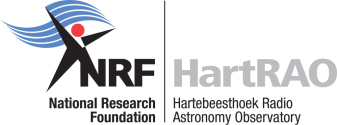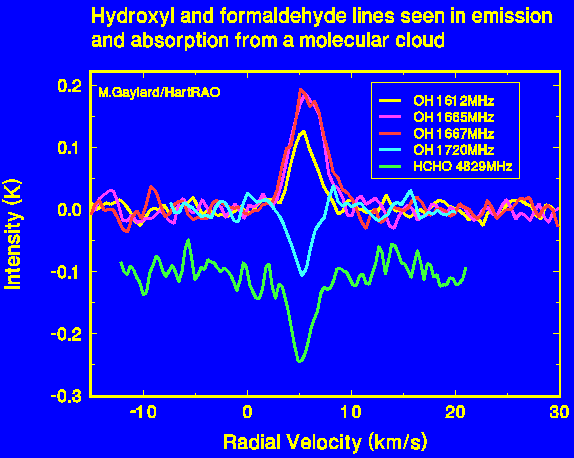Four lines of hydroxyl from a molecular cloud are shown
above, labelled as OH with the frequency at which the line is
emitted alongside. The lines are the big bumps up or down in the middle of
the image. The small ripples are caused by noise in the receiver. When the
line sticks up above the noise, it is in
emission. If it sticks down below the
noise, it is in absorption.
These lines were all observed at the same position in the cloud. The
physical temperature of the cloud is probably about 10 K
(Kelvins, or degrees above absolute zero, which is -273 Celcius). The
density of the cloud is low, ranging from 100 to 1000
particles per cubic centimetre, which is a good vacuum by Earth standards.
Owing to the low density, the molecules collide infrequently, and are not in
equilibrium. If the hydroxyl molecules were in equilibrium, we would expect
to see all four hydroxyl lines in emission, and the strengths of the 1612,
1665, 1667 and 1720 MHz lines would be in the ratio 1:5:9:1.
The intensities of the hydroxyl lines are interlinked. The equations
describing how they are linked can be solved if all four lines are observed,
as we did here. In this case, the excitation temperatures
of the 1665 and 1667 MHz lines are about +6 and +11 K
respectively, which are close to the physical temperature.
The excitation temperatures of the 1612 and 1720 MHz
lines are -2 and +1.5 K, much further from the physical temperature.
Negative temperatures mean that more of the molecules than expected are in
the upper energy level giving rise to the line rather than the lower. It
does not mean that the molecules have a negative absolute temperature. The
1612 MHz line seen here therefore is actually weak stimulated
emission. The 1720 MHz line is seen in absorption because its
excitation temperature is below the brightness temperature of the background
radio radiation, which is about 5 K at this position. Most of this radiation
comes from the cosmic microwave background. This is what we
can still detect of the "Big Bang" which marked the
creation of the universe. The remainder of the radio emission comes from the
part of the Milky Way behind the molecular cloud.
The formaldehyde line (HCHO) is seen in absorption in
the spectrum above, for the same reason as for the OH 1720 MHz line. Its
spectrum has been shifted below the hydroxyl spectra for clarity.
The velocity of the formaldehyde along the line of sight (radial
velocity) matches that of the hydroxyl lines (+5 km/s), because the
hydroxyl and formaldehyde molecules occur in the same volume of gas. A
negative velocity ("blue-shift") means that the object is
moving towards us, a positive velocity ("red-shift") that
is moving away from us. The velocity of +5 km/s (18000 kilometers per hour, or
about 10000 miles per hour) is low, because this molecular cloud is near
by in the Milky Way.
The width of the lines depends on the
temperature of the gas and the motions of the gas within
the cloud (turbulence). In this case the cold gas produces
very narrow lines. Here it can be seen that the hydroxyl lines and the
formaldehyde line all have about the same width of 3 km/s. This is quite
narrow by astronomical standards. Most of the line width in this case is due
to turbulence, because the temperature of the gas is so low.

